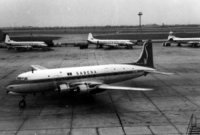
Heathrow Airport History
Heathrow airport was originally a private owned airfield call the Great Western Aerodrome. It was generally used for test flying and at that time commercial flights were taking off from Heston & Hanworth Park airfields, both nearby.
In 1943 Heathrow Airport was proposed. It was to be called Heathrow Airport after the hamlet of Heathrow, located where Terminal 3 now stands. It was destined to be a civil airport from the start, but to quell any public an anxieties and to help prevent a public enquiry it was announced that the airport was to be constructed for the RAF. In 1944 the airport was requisitioned by the Air Ministry to be developed as a major transport base for the Royal Air Force. Work therefore started on building a runway, which was totally unsuitable for civil avaiation requirements, therefore enforcing the claims that it was for RAF use only. Needless to say this runway was left abandoned without ever being used since the war then ended and with that a prospect of huge civil aviation expansion was expected.
On 1st January 1946 the airport was transferred to the Ministry of Civil Aviation and the airport was formerly opened on 31 May 1946 and in its rush to open a tented terminal was used. There were just 9,000 flights in the first year of operating serving just 18 destinations. By 1947 three runways had been completed and work on another three was taking place, but shortly after this it was deemed unnecessary to build these extra three runways.

Air passenger numbers at Heathrow grew enormously and work on a terminal (now Terminal 2) commenced as did the building of 3,500 houses in Feltham, Heston & Stanwell to house the ever increasing workforce at the airport.
In 1955 Her Majesty The Queen opened the now Terminal 2 building and the tunnel which provides main road access to Heathrow's central area. A further terminal the 'Oceanic Terminal' now known as Terminal 3 was built and in 1968 Terminal 1 was opened. Terminal 4 opened in 1986 and currently Heathrow Airport is in the process of building Terminal 5. The airport now covers in excess of 1,200 hectates, (3,000 acres).




